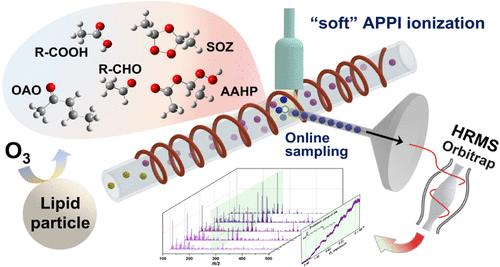Investigating the Kinetics of Heterogeneous Lipid Ozonolysis by an Online Photoionization High-Resolution Mass Spectrometry Technique
IF 6.7
1区 化学
Q1 CHEMISTRY, ANALYTICAL
引用次数: 0
Abstract
Lipid oxidation-induced imbalance in the redox system is one of the key causative factors leading to accelerated aging in living organisms and related diseases. Online sampling and analysis of the heterogeneous ozonolysis kinetics of lipid aerosols are highly important in revealing the oxidation-driven aging process of lipids. In this paper, an online detection method based on atmospheric pressure photoionization combined with ultrahigh resolution mass spectrometry (APPI-HRMS) is developed for real-time analysis of the heterogeneous reactions between lipid particles (oleic acid and squalene) and ozone. The online APPI-HRMS technique serves as an ideal platform for analyzing the heterogeneous oxidation of particles, exhibiting remarkable stability, sensitivity, and responsiveness across a wide range of particle concentrations. Owing to the distinctive characteristics of soft ionization, the heterogeneous effective oxidation rate of lipid aerosols was quantitatively measured. This has facilitated the detection of a series of fingerprint particle-phase products, including aldehydes, secondary ozonides, and hydroperoxides. Additionally, the kinetics evolution of these products with the ozone concentration was captured. Consequently, the ability of this online APPI-HRMS technique in assessing the multiphase oxidation of organic particles has been demonstrated, positioning it as a promising and feasible tool for revealing the heterogeneous reactions of particles.

利用在线光离子化高分辨率质谱技术研究异质脂质臭氧分解动力学
脂质氧化引起的氧化还原系统失衡是导致生物体加速衰老和相关疾病的关键致病因素之一。在线采样和分析脂质气溶胶的异相臭氧分解动力学对揭示脂质氧化驱动的老化过程非常重要。本文开发了一种基于大气压光离子化结合超高分辨率质谱(APPI-HRMS)的在线检测方法,用于实时分析脂质颗粒(油酸和角鲨烯)与臭氧之间的异相反应。在线 APPI-HRMS 技术是分析颗粒异相氧化的理想平台,在各种颗粒浓度范围内均表现出卓越的稳定性、灵敏度和响应性。由于软电离的显著特点,可以定量测量脂质气溶胶的异质有效氧化率。这有助于检测一系列指纹颗粒相产物,包括醛类、二级臭氧和氢过氧化物。此外,还捕捉到了这些产物随臭氧浓度变化的动力学过程。因此,这种在线 APPI-HRMS 技术在评估有机颗粒的多相氧化方面的能力已得到证实,使其成为揭示颗粒异相反应的一种有前途的可行工具。
本文章由计算机程序翻译,如有差异,请以英文原文为准。
求助全文
约1分钟内获得全文
求助全文
来源期刊

Analytical Chemistry
化学-分析化学
CiteScore
12.10
自引率
12.20%
发文量
1949
审稿时长
1.4 months
期刊介绍:
Analytical Chemistry, a peer-reviewed research journal, focuses on disseminating new and original knowledge across all branches of analytical chemistry. Fundamental articles may explore general principles of chemical measurement science and need not directly address existing or potential analytical methodology. They can be entirely theoretical or report experimental results. Contributions may cover various phases of analytical operations, including sampling, bioanalysis, electrochemistry, mass spectrometry, microscale and nanoscale systems, environmental analysis, separations, spectroscopy, chemical reactions and selectivity, instrumentation, imaging, surface analysis, and data processing. Papers discussing known analytical methods should present a significant, original application of the method, a notable improvement, or results on an important analyte.
 求助内容:
求助内容: 应助结果提醒方式:
应助结果提醒方式:


